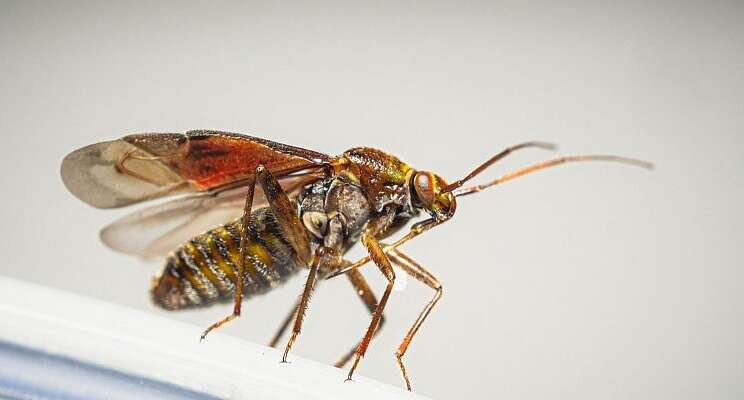Forecasting and controlling the European tarnished plant bug
Added on 07 March 2022

The problem
The European tarnished plant bug, Lygus rugulipennis, has been around for years in greenhouse horticulture, as have other harmful bugs such as the common green capsid bug and the common nettle bug. However, control is becoming increasingly difficult, especially in floriculture, because less and less broad-spectrum pesticides are used. Another cause is that due to climate change the bugs develop faster and reach higher densities, which increases the pest pressure from the greenhouse environment. Last year the problems with plant bugs were limited, but the years before were characterized by mild winters and hot summers, which resulted in high pest pressure.
The most effective way to prevent infestations by the bugs is to screen the roof vent windows. However, this is not feasible for every company and crop. Selective chemical control is also becoming increasingly difficult, especially due to the increasing use of Orius for the control of thrips. The use of pesticides against the European tarnished plant bug will quickly also have a negative effect on predatory bugs. Biological control of plant bugs in the greenhouse is very difficult. There are predators and parasitic wasps that control the eggs and nymphs of plant bugs, but these do not affect the adult stages, while that is precisely the stage that migrates to the greenhouse. Moreover, the adult bugs can live for months and thus cause damage all that time. Control should therefore be aimed at the adult stages.
Forecasting migration
The European tarnished plant bugs overwinter as adults and can become active early in the year and migrate to greenhouses. However, most influx seems to occur after the first and second generation outside of greenhouses on herbaceous plants. For the control of Lygus bugs it is valuable to be able to predict these migrations to greenhouses. The institute East Malling Research in the UK developed some years ago a model that can be used to identify and predict the development of the first and second generation on herbaceous plants based on temperature sums.
When the development is close to reaching the adult stage, you can reasonably predict based on weather estimates when the adult stage has been reached and the first flights can be expected. Over the past 2 years, WUR Greenhouse Horticulture has validated this model with data from growers. Also the assumptions for generation developmental time and survival of nymphs at low temperatures have been tested. The nymphs turned out to be very resistant to low temperatures. After 48 hours of exposure to 5 degrees below zero, 80 percent of the nymphs survived. This information was important for the development and validation of the model.
Reports from growers about the first influx appeared to correspond reasonably well with the results of the model. However, the bugs can also hibernate in greenhouses, which means that some growers report damage much earlier than what could have been possible according to the model.
Research in the Czech Republic
Besides the temperature depended developmental time, also the climatic conditions that determine flight behaviour are important to know. In the eighties a lot of research was already done in the Czech Republic where they studied the flight behaviour of the European tarnished plant bug with light traps. These studies indicate that quite specific conditions are favourable for migrations. For example, the bugs mainly flew during the evening between 6 pm and 1 am. The temperature during these flights is crucial. Bugs were only caught with lamps when the evening temperature was above 14 degrees Celsius at 9 p.m. Most activity of flying adults was observed on warm, windless summer evenings at a temperature above 20 °C at 9 p.m. Furthermore, peaks of flight activity can often be linked to the loss of important host plants during mowing.
These specific conditions for flight activity can be linked to the development model, so that a reasonable estimate can be made when massive influxes of plant bugs can be expected. Upcoming year, WUR will organize a webinar together with Glastuinbouw Nederland to explain the model, so that growers can get to work with it themselves.
Repel and control
Predicting plant bug migrations to greenhouses will ultimately have to be linked to an action. Temporarily closing the vents at plant bug migration moments is not an option for the crop. The temperature would rise too quickly on those warm summer evenings. However, during the periods when an influx of plant bugs can be expected, growers could start monitoring with traps and, at the moment that the pest is detected, they could apply an application with a specific biocontrol product, such as entomopathogenic fungi. However, the current products based on these fungi show so far limited effectiveness against the adult bugs. The project is now further investigating whether the bugs can be repelled with odours that can be applied at specific times.
Photo Courtesy of Wageningen University & Research
Source: Wageningen University & Research
More news















